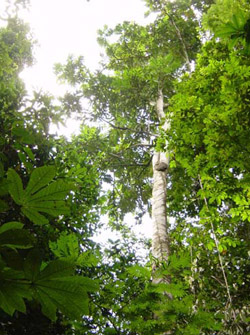Summary:
Botanists working have described a new species of tree with commercial significance in Guyana. The discovery is published in Brittonia, a journal put out by the New York Botanical Garden.
The new species, Carapa akuri, had long been mistaken for Carapa guianensis, a tree widely dispersed across the Amazon and commonly logged for the furniture industry.
The find is significant because it is an important source of natural oil for Makushi Amerindians and the cosmetic market, according to Pierre-Michel Forget, lead author of the paper that describes the species and a researcher at the National Museum of Natural History in Paris.
 Photo by Pierre-Michel Forget |
“Akrui is an important source of sustainable development within the Iwokrama forest,” Forget told mongabay.com, referring to Guyana’s innovative forest reserve that has become the centerpiece for the country’s efforts to protect its forests through sustainable management.
Oil from Carapa’s large seeds are used for a variety of purposes, including treatment for dandruff and rashes, insect repellent, and as a moisturizer. When produced from Carapa guianensis the oil is known as Crabwood oil or Andiroba.
The species is also endemic to the region and may be at risk from logging, providing new impetus for protecting its diverse rainforest habitat.
“This single tree can save a forest,” said Forget.
Carapa akuri is named after the red-rumped agouti (Dasyprocta leporina) which is likely the main seed disperser of Carapa in Guyana. The indigenous Makushi named for the agouti is “akuri”.
Co-authors on the paper include Odile Poncy of the Centre National de la Recherche Scientifique (National Center for Scientific Research) in Paris, Rachel Thomas of Iwokrama, David Hammond of NWFS Consultancy, and David Kenfack of the Missouri Botanical Garden.
More information:
CITATION:
Forget, P.-M., Poncy, O., Thomas, R. S. Hammond, D. S. and Kenfack, D. A new species of Carapa (Meliaceae) from Central Guyana. Brittonia, 61 (4): 301-402. 2009.
Related articles
Eco-label for rainforest products could boost sustainability December 06, 2009
Tropical forests around the world continue to fall, largely the result of logging and conversion to agriculture. But new hope for forests has emerged under a scheme that would reward countries for reducing greenhouse gas emissions from deforestation and degradation. Some variations of the concept, which is known as REDD, would allow for “sustainable forest management” (SFM), that is, reduced impact logging of forests, as well as harvesting of non-wood forest products (NWFPs) like seeds, fruit, and game. But the extent to which this harvesting affects forest ecology, and therefore carbon sequestration, is still poorly understood.
Are Brazil nuts really sustainable? Only if hunting is controlled December 20, 2006
A lot of rainforest conservation initiatives embrace sustainably harvested non-timber forest products (NTFPs) like seeds and nuts as a means to provide income to locals without harming the forest. Operating on the premise that such products are eco-friendly, hundreds of outfits ranging from Whole Foods to the Body Shop to Ben & Jerry’s Homemade Ice Cream tout their use of sustainably harvested Brazil nuts and related products. But really, how sustainable are these products?







